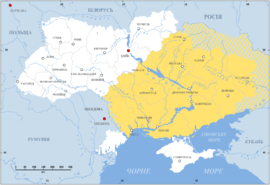Wild Fields
| Wild Field | |
|
| |
Map of the Wild Field in the 17th century | |
The Wild Fields or the Wilderness (Latin: Loca deserta, sive campi deserti inhabitati; Ukrainian: Дике Поле Dyke Pole, Russian: Дикое Поле, Polish: Dzikie pole, Lithuanian: Dykra) is a historical term used in the Polish–Lithuanian documents of the 16th and 18th centuries[1] referring to the Pontic steppe north of the Black sea and Azov sea. The location of this geographic reference is somewhat ambiguous and usually defined between the Don River on the east, Kiev on the north, and the left tributaries of the Dniester on the west.
The territory was ruled by the Golden Horde during 1240–1362. Algirdas, Grand Duke of Lithuania, took control of the western territory after the Battle of Blue Waters. It was known by the Lithuanians as Dykra. In 1399, after the Battle of the Vorskla River, the territory was taken back by Temur Qutlugh, the khan of Golden Horde. In 1441, the territory, known as Yedisan, became part of the Crimean Khanate. In the 16th century, it became part of the expanding Ottoman Empire. In the late 18th century with the Ottoman decline, the area became a part of the Russian Empire and the Nogais were deported to other parts of the Empire[citation needed]. Currently the area is a part of Ukraine, Moldova, and Russia.
There were two notable fortress towns located in the area: Kara Kerman (Ochakiv) and Khadjibey (Odessa). The Wild Field was traversed by the Muravsky Trail and Izyumsky Trail, important trade routes and also warpaths used by the Crimean Tatars to invade and pillage the Grand Duchy of Moscow. However, the area was only sparsely populated with nomadic Nogais and consisted mostly of unpopulated steppes. The Crimean-Nogai Raids, a long period of raids and fighting between Tatars, Ruthenians, Grand Duchy of Lithuania, the Nogai, and the Crimean Khanate, brought considerable devastation and depopulation to this area prior to the rise of the Zaporozhian Cossacks. The region was gradually settled by runaway peasants and serfs who made up the core of the Cossackdom.[citation needed] As soon as a process of colonization was afoot, the term "Wild Fields" gave way to more specific designations, such as Zaporizhia, Sloboda Ukraine, and (later still) Novorossiya.[citation needed]
References
- ↑ Camporum Desertorum vulgo Ukraina by Guillaume Le Vasseur de Beauplan, Cum Privilegio S.R.M. Poloniae. Gedani 1648; Campi Deserti citra Boristhenem, abo Dzike Polie Polish–Lithuanian, by Ian Jansson, c. 1663, Amsterdam
